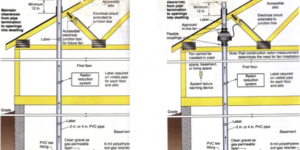Whether you’ve had your home tested for radon yet or not, it’s important to understand the two most common types of radon mitigation systems available. If you don’t know your radon levels or it’s been more than two years since your last test, purchase a home kit or call a radon testing company to measure your home’s radon levels. If it’s above 4 pCi/L, it’s time to install or upgrade your radon reduction system.
Radon mitigation systems reduce the amount of radon in your home. Radon is both odorless and tasteless. However, radon is still extremely dangerous and is the leading cause of lung cancer after smoking. It’s important to ensure your home or business has a proper radon mitigation system in place to keep your family or coworkers safe. The best way to choose a radon mitigation system is to learn about the differences between passive vs. active radon systems.
Active Radon Mitigation Systems
Active soil depressurization systems use a fan to suction radon gasses from under the home. It is far more effective than a passive system and is the only type of system recommended for existing (non-new construction) homes.
An active radon mitigation system, with an electric vent fan and monitoring system, has a vent pipe that stretches from the soil under the lowest layer of the home to up above the roof outside the home. It is a permanent system with the fan running 24/7, and it needs little maintainece. The fans draw about 75 watts and tend to last seven to ten years.
Passive Radon Mitigation Systems
Passive radon systems are like active systems but lack a fan. This type of radon mitigation system uses the natural pressure differential to create an airflow and move the radon out. A passive system is helpful in homes with low levels of radon, but can’t deal with higher levels of the gas, which is why this is the best radon mitigation system choice for new buildings that can’t be tested for radon yet. Research has indicated that in homes with high radon, more than 70% of the time, a passive system will not get radon levels to acceptable levels.
Passive to active conversions are possible—a process which is called activating. Activation involves installing a fan and routing electricity. It may also involve putting in a monitoring system as well, depending on requirements.
You probably won’t really have to make the choice between a passive versus an active radon mitigation system. If you have high radon levels, a passive system is usually not enough to clear the radon out of your home. Depending on where you live, passive radon mitigation in an existing structure may not even be permitted.
DuPage Radon Contractors
If you’re ready to get one of these types of radon mitigation systems installed in your home, call DuPage Radon Contractors today. We are experts in installing both passive and active systems, as well as in activating existing passive systems. We’ve installed over 12,000 radon reduction systems over the last 25 years. DuPage Radon Contractors knows the Chicago area and how to protect your family and co-workers.





